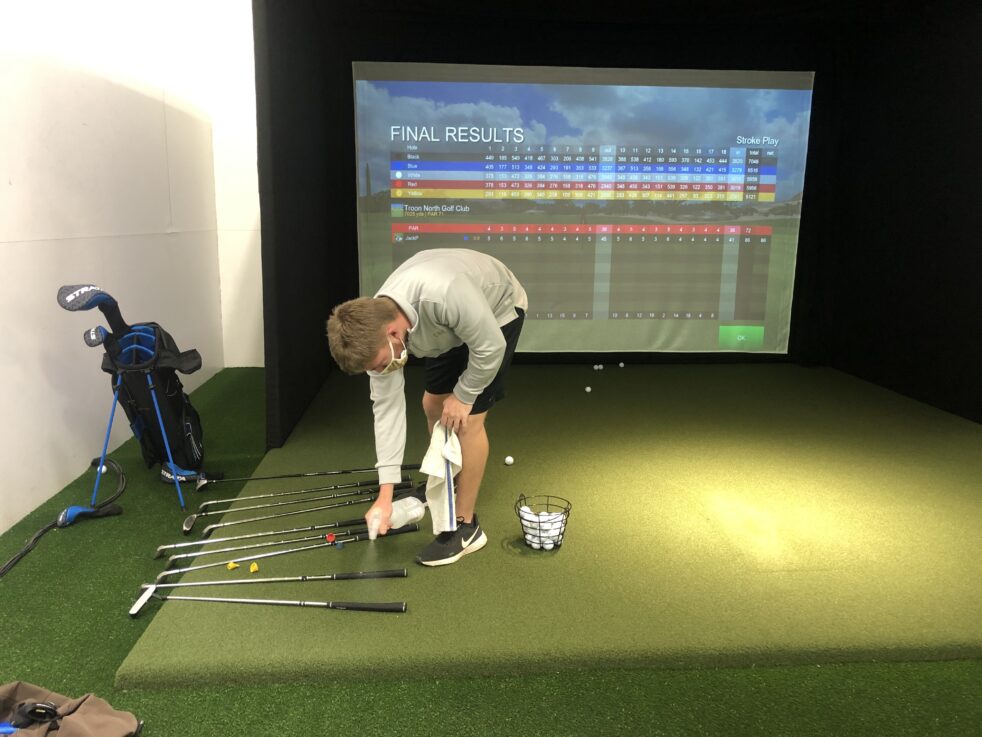After the Thanksgiving break in the Fall 2020 semester, the CRC debuted its newest gadget: a multi-sport simulator where one could play golf, baseball, hockey, soccer golf or soccer. The simulator fills in the space where racquetball court #1 currently sits. The floor of the court is now covered in artificial turf, with the simulator pushed against the back wall. It spans nearly the entire width of the room, with just enough space to put equipment between the walls and simulator.
In case you haven’t heard of or used a golf simulator, it is a very impressive replication of playing golf outside. A standard simulator has a camera and or sensor that can spot where the golf ball is on the ground, where the player is standing, and what club they have in hand.
In front of the player is a thick plastic screen that can easily withstand a full golf shot, where an animated golf course or driving range is projected.
The sensor then tracks your swing pattern, how hard the ball was hit, where on the club the ball was hit, and how much spin was generated. As the ball is hit against the screen, the animation shows the ball flight and where it lands.
The simulator at the CRC is made by TruGolf, who makes a variety of golf and multi-sport simulators. The CRC’s model is aptly called the TruGolf MultiSport. Technically, the simulator is built with golf in mind, and you buy an add-on to support the other sports. The listed price of the add-on is $7,495. This model also supports a bonus pack that would include dodgeball, disc golf, and bowling. The base simulators are priced anywhere from $10,495 to $18,995 on TruGolf’s website.
For anyone with a CRC membership, having this available makes the price tag of the membership even sweeter. Playing golf is notoriously expensive, regardless of if one is just hitting the driving range or playing actual holes. Usually, the cheapest way to play a lot is to be on a school golf team that subsidizes most, if not all, of the costs, whether in college or high school.
At Tech, golf usually hasn’t been an accessible option for students unless they were on the golf club, golf team, or had transportation to a course somewhere in Atlanta. It’s very unlike most other sports here that you can find very easily (pickup soccer, basketball, ultimate frisbee, badminton, etc.). The introduction of the simulator changes that.
Currently, the CRC opens up the simulator for 45-minute time slots where the user can do whatever sport they want.
Golf clubs (both righty and lefty), hockey sticks (righty only), baseball bats, and the various balls needed for each sport are provided. For golf, rubber tees are also provided.
Upon entry, a student employee sets up the simulator for the user with their choice of sport, and the user logs into a TruSport account that allows them to pause games for later. The time slots are only 45 minutes to allow time to sanitize and clean all the equipment in between uses.
Golf is by far the most comprehensive option available. It has multiple formats of golf arcade games, several driving ranges and a large plethora of real life courses that can be played.
Courses include Royal Liverpool (previous hosts of the British Open), Torrey Pines, and Georgia’s own Sea Island Golf Club.
For baseball, the user watches a pitcher on the screen throw the ball and has to time their swing hitting a ball off a tee. There are various zones on the field display that correspond to types of hits, or an out.
Soccer golf is essentially golf, but just using a soccer ball. The game has four different courses that can be played at different skill levels.
A full powered kick goes further than one can actually kick it, but it still has the sensitivity of power and speed down like it does for golf. The hole is bigger for soccer than for normal golf to adjust for the size of a soccer ball.
Hockey has three modes. Two of them are shootout style where the player tries to shoot it past the goalie, and the other mode is target practice.
The third mode has the player trying to shoot a long shot toward the goal without hitting skaters in between the player and the goal.
Soccer has the same game modes as hockey, except the long kick game is a mode where the player is trying to pass it to a teammate on the screen as they run.
One of the best benefits to using the simulator is the cost for a student to use it.
The CRC fee per student is $105 per semester. With how fast the simulator moves through shots, one could hit anywhere from 70-100 shots in the 45 minute time slot given they only play golf.
If one were to go to a driving range at a local course such as Charlie Yates for this example, a bucket of 100 balls would cost $13.
That means if one were to use the simulator at least nine times in a semester, it becomes cheaper than going to a driving range. That is before using the CRC for any of its other amenities.
It is an incredible deal for the price students pay, and will likely be the most affordable way for Tech students to get better at golf or learn how to play.
The simulator is for single person use only at the time. However, it seems as if the simulator definitely has the potential to allow for multiple people to use it at a time as once COVID-19 restrictions start to ease.
